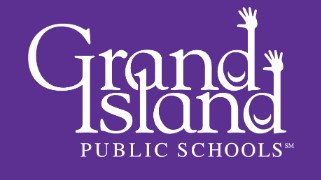
Grand Island Senior High School receives $10,000 to create LGBTQ mural; school district pays Panorama $52,000 annually for surveys and services
Incidents
In 2022, the “It Gets Better Project” allowed schools to “apply for up to $10,000 in grant funding to support school-based projects empowering LGBTQ+ students.” The project was called “50 States. 50 Grants. 5000 Voices.” The organization specifically pointed out that “grant funding” even went to schools in “traditionally conservative areas.” Grand Island Senior High School is a school that applied for a grant and received a full $10,000. The “It Gets Better Project” stated:
We are so excited to finally be able to announce all of the grant recipients, with each school receiving the full $10,000 in funding. Fifty grants are being awarded in 40 states plus Washington D.C., including many traditionally conservative areas. Submissions were received from a wide range of small rural towns, average-sized suburbs, and large urban cities.
The organization claimed that these grants were made available to schools thanks to the “generous support of American Eagle Outfitters, Inc. (AEO) through American Eagle and Aerie customer donations from all 50 states via their Real Rewards loyalty program, as well as in-store pin-pad promotion during Pride Month 2021.” In reference to Grand Island Senior High School, the “It Gets Better Project” stated that the grant “will fund the creation of a mural to represent all identities in the LGBTQ+ community.”
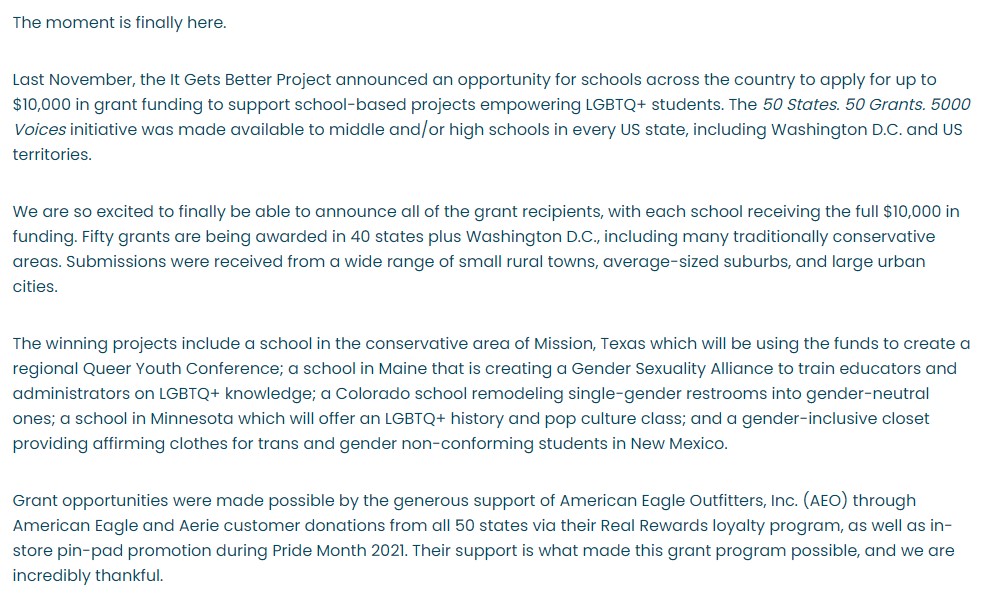

The “It Gets Better Project” is an organization that promotes LGBTQ issues to children. The organization states that its mission is “to uplift, empower, and connect lesbian, gay, bisexual, transgender, and queer (LGBTQ+) youth around the globe.” This includes through “storytelling and media.” The organization explains: “We work in all forms of media to bring messages of hope to LGBTQ+ youth, spark conversations about the challenges they confront, and inform and positively influence their sexual orientation and gender identity journey.”
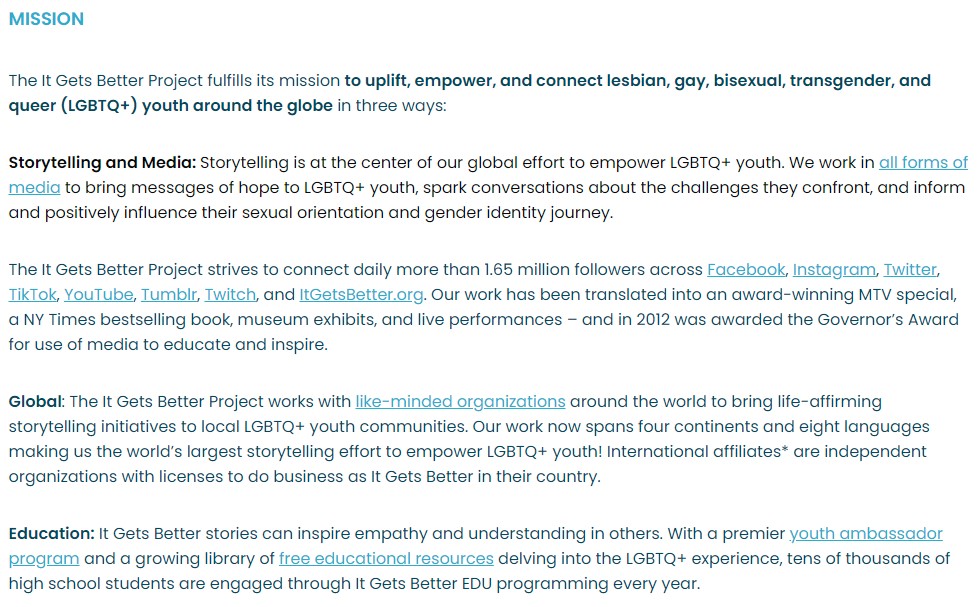
The school district – Grand Island Public Schools – openly promotes using Panorama surveys. The school district states: “Grand Island Public Schools (GIPS) has been using Panorama, a well reputable and robust technology/surveying platform, in recent years. We piloted the program for two years starting in 2017 and moved to a districtwide usage in 2020.” The district then states that it pays Panorama Education Inc. a total $52,000 annually for the company’s services.

Panorama Education Inc. is an organization known for helping schools throughout the country survey the race, ethnicity, sexual orientation, and gender identity of students in an effort to push “equity and inclusion” in school systems. The organization offers an “Equity and Inclusion Survey” to “help schools and districts track the progress of equity initiatives through the lens of students and staff, identify areas for celebration and improvement, inform professional development, and signal the importance of equity and inclusion to the community.”

On June 11, 2020, the school district’s Board of Education passed the “Resolution on Eliminating Racism.” This resolution states that the school district “has formally adopted a strategic plan with equity embedded throughout all objectives and student success measures, including one objective entirely devoted to equity.” The resolution additionally states that the school district is “dedicated to eliminating racial injustice at all levels and in all areas of our district.”
The resolution further explains that the district “recognizes the value of training our staff on culturally responsive teaching practices.” The term “culturally responsive” is often used to describe a method of teaching that includes the race and ethnicity of students as part of the lessons taught in classrooms. The resolution then states the district’s commitment to “anti-racism”: “Even as we acknowledge all of these things, we must do more to address our individual and district-wide biases, to truly commit GIPS to anti-racism and eliminating racial injustice wherever it exists in our district while continuing to prioritize equity in all aspects of our actions.”
The superintendent also wrote a letter about “implicit and unconscious bias” and “systemic racism.” She stated:
But not all discrimination is as blatant as a police officer’s knee on a man’s neck. Infractions of implicit and unconscious bias are often undetected, overlooked or dismissed. Our greatest hope to heal the wounds of systemic racism is finding the courage to convey the truth about our individual experiences – the good and the bad.
The superintendent also explained that the district “must lift higher our commitment to racial equity; lift higher our understanding of race and bias; and lift higher our students by giving them knowledge, education and a voice.” She then appeared to state that her goal is to turn students into political activists. She stated: “We must continue to realize our district’s vision: Students prepared to make positive contributions to society and thrive in an ever-changing world.”
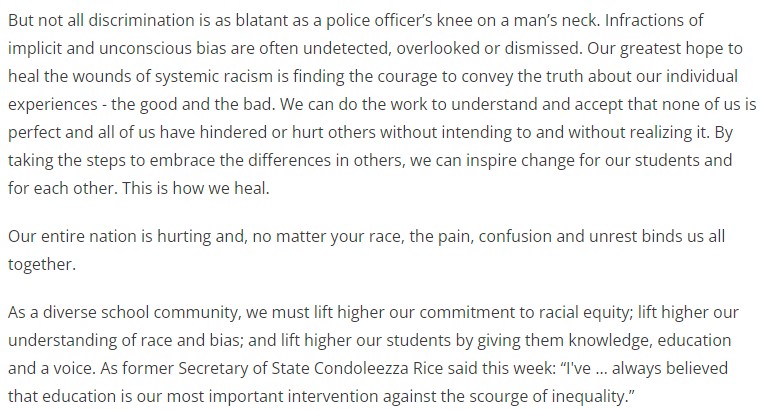
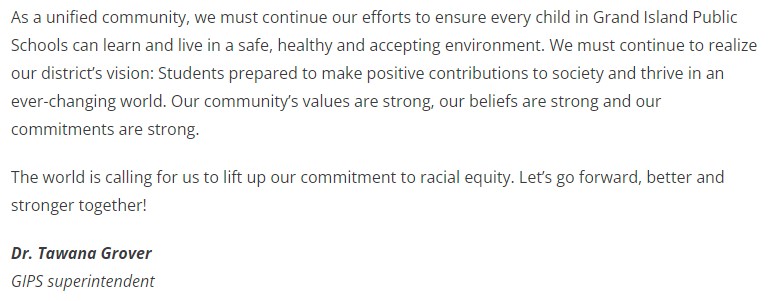
The school district’s website has an equity page that states a goal of “addressing our individual and district-wide biases.” The district then states: “Policies and practices will be identified, addressed, and monitored for inequities, racism and discrimination at the classroom, school, and district level.” The school district then appears to state again that a goal is to turn students into political activists: “Students develop self-advocacy and use their voice for positive change.”
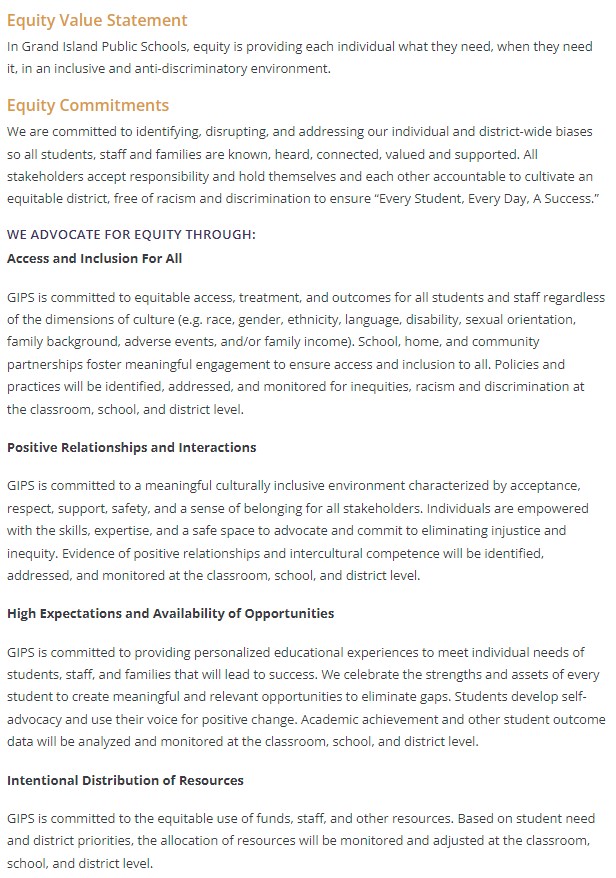
On September 10, 2020, the school district adopted a policy titled “Equity in Grand Island Public Schools.” The policy states:
We are committed to identifying, disrupting, and addressing our individual and district-wide biases so all students, staff and families are known, heard, connected, valued and supported. All stakeholders accept responsibility and hold themselves and each other accountable to cultivate an equitable district, free of racism and discrimination to ensure “Every Student, Every Day, A Success.”
The policy then states that the Board of Education even holds “students” and “parents” accountable for creating a “culture of equity.” The policy states: “The Board holds itself and all district and school site decision makers, faculty, support staff, students, parents, and community partners accountable for building a district-wide culture of equity.”
The school district has a strategic plan titled “GIPS on Track to Thrive 2025.” The plan appears to focus on equity and outright states that “ESSER dollars and CARES Act funds” are being used to implement “equity.” The plan states that the school district has used this funding to create an “Equity Task Force” that is in the “process of building [an] equity action plan.” The district also used the funding to solidify “commitment to provide each individual what they need, when they need it, in an inclusive and anti-discriminatory environment.”
The strategic plan also mentions an “equity plan moving forward” that consists of “eight workgroups.” These workgroups are “discipline and attendance,” “student achievement,” “graduation,” “academic acceleration,” “differentiated support,” “early childhood/early literacy,” “communication,” and “extracurricular activities.” The goal of these workgroups is to create “system changes” that could potentially “include budget, staff, policies and practices, and will eliminate or reduce equity disparities.”
On March 14, 2022, Superintendent Tawana Grover wrote another letter that started with the phrase: “Literacy is a form of liberation.” She then targeted parents who appeared to have been worried about books in the district’s libraries promoting Critical Race Theory (CRT). She stated:
The attempt to spotlight library resources as a widespread issue worthy of scrutiny is misguided and it needs to cease. It misses the heart of what we aim for in providing rich education experiences for each and every one of our students. Especially as it pertains to the conversation surrounding Critical Race Theory (CRT).
The superintendent then appeared to vaguely endorse the tenets of CRT in this letter while denying that CRT is taught in the district’s classrooms. In the superintendent’s previously mentioned letter, she openly supported the idea of “racial equity,” which is a core component of CRT. In this second later, she stated:
What is commonly referred to as CRT is not a curriculum. Nor has it been formalized as a program implemented in Grand Island Public Schools. When we reference important topics surrounding the teaching of history, social studies, civics, and community engagement we have a greater responsibility as educators to speak to what is actually taking place in our classrooms; what is being taught; what is required by the state; what the Board of Education elects to implement from a policy level.
Later in her letter, the superintendent also appeared to admit that CRT material is in the school district’s libraries. She explained: “But when we speak of CRT specifically — especially as it pertains to library resources — it is important to understand that we are not speaking of curriculum; we are, instead, speaking of generic opinions and potentially misinformed anecdotes.” She then explained that the district’s curriculum should include discussions about the identities of students. She stated: “We agree that race, social issues, illuminating our history, and how we advocate for our students while celebrating their heritages are vital to the efforts of empowering our students to thrive.”
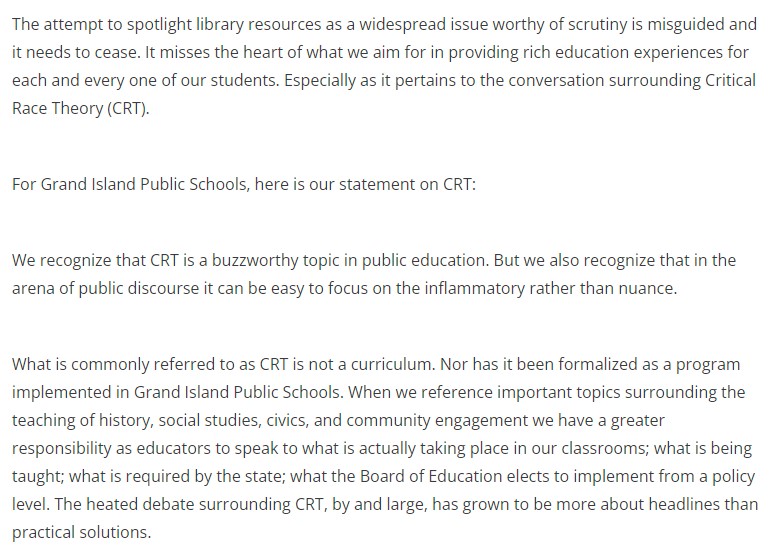

Stay Informed

